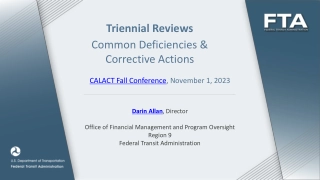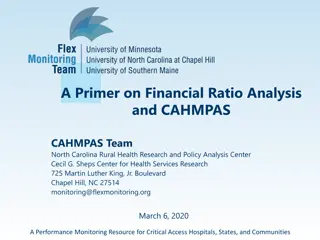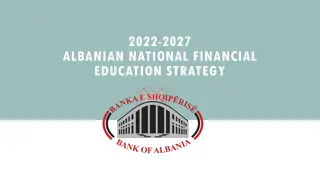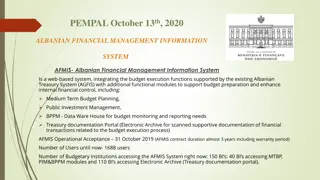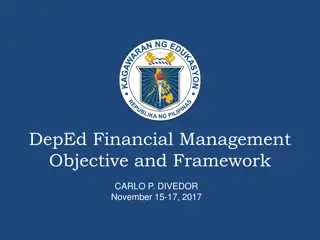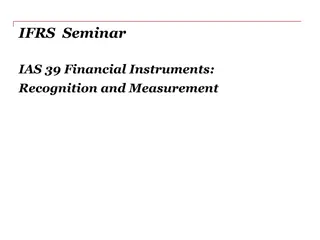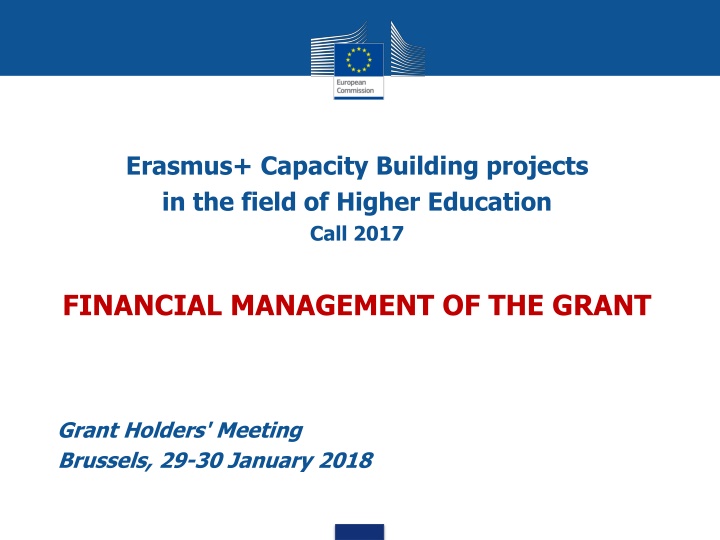
Financial Management Guidelines for Erasmus+ Capacity Building Projects
Learn about the financial management aspects of Erasmus+ Capacity Building projects in Higher Education, including financing principles, budget models, funding rules, budget ceilings, and budget transfers. Explore key topics such as actual costs, unit costs, grant management, financial reporting, and budget allocations.
Download Presentation

Please find below an Image/Link to download the presentation.
The content on the website is provided AS IS for your information and personal use only. It may not be sold, licensed, or shared on other websites without obtaining consent from the author. If you encounter any issues during the download, it is possible that the publisher has removed the file from their server.
You are allowed to download the files provided on this website for personal or commercial use, subject to the condition that they are used lawfully. All files are the property of their respective owners.
The content on the website is provided AS IS for your information and personal use only. It may not be sold, licensed, or shared on other websites without obtaining consent from the author.
E N D
Presentation Transcript
Erasmus+ Capacity Building projects in the field of Higher Education Call 2017 FINANCIAL MANAGEMENT OF THE GRANT Grant Holders' Meeting Brussels, 29-30 January 2018
REGULATORY FRAMEWORK EACEA Documents Application Your documents National legislation & Institutional regulation Any prior authorisation from EACEA 2
OUTLINE 1) Financing principles 2) Actual costs 3) Unit costs 4) Management of the Grant 5) Financial reporting 6) Final grant 7) Checks & Audits NB: Please note that this document has no legal value 3
BUDGET MODEL (ANNEX III OF GRANT AGREEMENT) EUR I STAFF COSTS 340.000 II TRAVEL COSTS 150.000 III EQUIPMENT 150.000 IV COSTS OF STAY 160.000 V SUBCONTRACTING 50.000 TOTAL GRANT (total I-V) 850.000 4
1) FINANCING PRINCIPLES Funding rule & Financing approach Budget headings and ceilings Budget transfers Eligible / Ineligible costs 5
FUNDING RULE & FINANCING APPROACH Co-funding principle Grant Total costs of the project Grant (combination of two different financing approaches) AC: Actual costs (Equipment and Subcontracting) UC: Unit Costs (Staff, Travel and Costs of stay) 6
BUDGETHEADINGSANDCEILINGS Staff costs (UC) Max 40% of grant (Art I.3 of GA) Travel costs (UC) no ceiling Costs of stay (UC) no ceiling Equipment (AC) Max 30% of grant (Art I.3 of GA) Sub-contracting (AC)Max 10% of grant (Art I.3 of GA) 7
BUDGET TRANSFERS (between budget headings) No prior authorization Even above the ceilings (for staff, equipment and subcontracting) Increase UP to 10% Increase by MORE than 10% Amendment Ceilings cannot be exceeded Staff costs % of total grant in G.A. Proposed increase Effect on % of total grant 36% Decision Max ceiling: 40% 30% +20% Amendment possible Not allowed 35% +20% 42% 8
BUDGET TRANSFERS Example 1 amendment % of budget heading % of total grant Budget transfer % EUR result I STAFF COSTS 340.000 340.000 40% 40% II TRAVEL COSTS 150.000 150.000 17,6% 17,6% III COSTS OF STAY 150.000 -10.000 140.000 17,6% 16,5% IV EQUIPMENT 160.000 160.000 18,8% 18,8% +20% of budget heading V SUBCONTRACTING 50.000 +10.000 60.000 5,9% 7,1% TOTAL GRANT (total I-V) 850.000 850.000 9
BUDGET TRANSFERS Example 2 = NO need for amendment % of budget heading % of total grant Budget transfer EUR % result +8% of 340.000 I STAFF COSTS 340.000 +27.200 367.200 43,2% 40% II TRAVEL COSTS 150.000 -27.200 122.800 14,4% 17,6% III COSTS OF STAY 150.000 150.000 17,6% 17,6% IV EQUIPMENT 160.000 160.000 18,8% 18,8% V SUBCONTRACTING 50.000 50.000 5,9% 5,9% TOTAL GRANT (total I- V) 850.000 850.000 10
ELIGIBLE COSTS Article II.19.1 Grant Agreement Incurred during the eligibility period Foreseen in the application/budget In connection with the action/necessary for project implementation Identifiable, verifiable, recorded in accounting records Comply with requirements of tax and national legislation Reasonable, complying with sound financial management (economy and efficiency) 11
INELIGIBLE COSTS 1) Costs NOT fulfilling requirements of Art. II.19.1 2) Art. I.10.4/II.19.4 examples: equipment such as: furniture, motor vehicles, alarm systems costs linked to the purchase of real estate activities not in project beneficiaries' countries (Annex IV), unless prior authorisation Exchange losses in kind contribution excessive expenditure deductible VAT 12
QUIZ 1) WHENDECLARINGCO-FINANCINGATFINALREPORTINGSTAGE, IS THEREAMINIMUMAMOUNTTODECLARE? a. No b. Yes, an amount representing minimum 10% of the costs declared c. Yes, an amount representing minimum 10% of the costs declared, but only for unit costs 2) CAN I INCREASETHESTAFFCOSTSFORAPROJECTPARTNERBY 15% WITHOUTREQUESTINGANAMENDMENTTOTHE GA (IFTHISISJUSTIFIED BYTHEPROJECTACTIVITIES) ? a. Yes, as far as the budget heading "staff costs" at project level does not increase by > 10% (and that the partnership agrees) b. No, never c. Yes, only if the staff costs of the partner do not exceed 40% of the total budget of the partner 13
2) ACTUALCOSTS Definition VAT Exchange rate Tendering procedure Equipment Subcontracting 14
ACTUALCOSTS - DEFINITION Expenses actually incurred (Documented and justified with corresponding level of cost) Example: Reported cost (laptops) of 1.500 EUR = Supporting documents to the value of 1.500 EUR 15
VAT (ART. II.19.4 GA) Ineligible Unless official document from competent authorities proving that the corresponding costs cannot be recovered Check with NEO/EU Delegation if an agreement exists between the EU and the Partner Country 16
EXCHANGERATE (ART. I.10.2 GA) 2 Which exchange rate should be applied? 1) From start of eligibility period until receipt of second pre-financing: monthly rate of reception of FIRST PRE-FINANCING 2) From date of receipt of second pre-financing until end of eligibility period: monthly rate of reception of SECOND PRE-FINANCING Rate to apply: http://ec.europa.eu/budget/contracts_grants/info_contracts/inforeuro/index_en.cfm EXAMPLE 1st Pre-financing: 23 Dec 2017 2nd Pre-financing: 22 Aug 2018 Invoice date: 09 January 2018 Applicable monthly rate: December 2017 All transactions must be declared in EUR in the Final Report 17
PROCUREMENTOFGOODS/SERVICES Less than 25.000 Best value for money Tendering procedure 25.000 - 134.000 National Legislation More than 134.000 18
EQUIPMENT Relevant to the objectives of the project foreseen in the application Total purchase cost (no depreciation) Exclusively for Partner Country Higher Education Institutions Recorded in inventory of institution Labelled with E+ stickers Installed (available for project participants) as soon as possible Not foreseen in the application? Prior authorisation from Agency Prior 19
SUBCONTRACTING Implementation of specific tasks, by third party, to which a contract is awarded by one/several beneficiaries Examples: Evaluation activities/auditing IT courses, Language courses Printing, publishing and dissemination activities Translation services Web design and maintenance Logistic support for the organisation of events Not foreseen in the application? Prior authorisation from Agency NO project-management related tasks 20
SUPPORTINGDOCUMENTS To keep with project accounts Invoice(s) and proof of payment > EUR 25.000 < EUR 134.000: tendering procedure and three quotations from different suppliers EUR 134.000: procedure according to national legislation Registration in the inventory Equipment Invoice(s) and proof of payment > EUR 25.000 < EUR 134.000: tendering procedure and three quotations from different suppliers EUR 134.000: procedure according to national legislation Tangible outputs/products Travel activities of subcontracted service provider: copies of travel tickets, boarding passes, invoices and receipts Subcontracting To send with Final Financial statement: EUR 25.000: copies of subcontract, invoice and competitive offers Any prior authorisation from the Agency 21
1) DO I HAVETOLAUNCHATENDERINGPROCEDUREFORACONTRACT VALUEOF 23,000 EUR? a. No, even if my institution requires to do it b. Yes, but the Agency should be informed c. No, unless my institution and/or the national legislation requires to do it 2) CANAPARTNERPURCHASEEQUIPMENTFORANOTHERELIGIBLE PARTNER? a. Yes, only if the project partner is a private HEI b. No, unless this was specified in the application c. Yes, if the cost effectiveness can be demonstrated and the equipment is delivered and recorded in the inventory of the partner country HEI. 22
3) WHICHSUPPORTINGDOCUMENTDO I NEEDTOKEEPTOJUSTIFYTHATAN INSTITUTIONCANNOTRECOVER VAT? a. A declaration signed by the legal representative of the institution b. An official document from the competent authorities c. A certificate from the financial department of the institution 23
3) UNITCOSTS Definition Staff costs Travel costs and costs of stay 24
UNITCOST - DEFINITION Fixed contribution multiplied by number of units, based on "Triggering events" (activities/outputs) No need to justify level of spending Financial control/audit declared unit costs supported with proofs of activities implemented Not divisible 25
Partnership Agreement Grant management cycle UNIT COST ACTUAL COSTS Based on estimated work programme Based on the estimated budget Grant allocation Beneficiary's own FINANCIAL "RECIPE" Grant Record costs actually incurred Implementation Justification of the Grant Based on activities actually implemented Based on costs actually incurred
1) IFWEHAVEESTIMATED 20 WORKINGDAYSINTHEAPPLICATIONFOR PRODUCINGTHEQASTRATEGY, WHICHISTHEWRONGSTATEMENT? a. We will certainly be granted 20 days at the final report stage if we can produce the expected supporting documents and QA strategy b. We can declare a different nr. days in the final report c. The actual nr. of days granted will be decided on the basis of the actual outputs (QA strategy) and other supporting docs. and will never be more than the nr. of days declared 27
2) THEACTUALCOSTSFORTRAVEL "X" ARE 30% HIGHERTHANTHE VALUEOFTHE UC a. The EACEA should be informed so as to authorised a higher grant contribution b. You can increase the UC value by 30% and justify it in your final report c. You have to balance this loss with savings made under other activities funded by UC and/or with co-funding provided by the partnership 28
STAFF COSTS Contribution to Institutions for Staff* performing tasks necessary to achieve the objectives of the project Unit cost = amount in Euro per working day per staff (not linked to the actual salary) Calculation 3 variables: staff category, country, number of days a) Categories: Managers, Researchers/Teachers/Trainers, Technical, Administrative nature of work performed, not status of individual b) Countryin which staff is employed, independently of where tasks are executed c) Number of days proportioned to the work carried out *Formal contractual relationship with a beneficiary organisation 29
STAFF COSTS Example A staff employed in Lithuania performing teaching activity for 3 days: 222 Euro (3 unit costs of 74 Euro each) One working day according to national legislation (7 to 8 hours) In principle max. 20 days/month or 240 days/year 30
STAFFCOSTS - EXCEPTIONS Individuals* not regularly employed by partner institutions can be assigned to the project on the basis of a contract against payment if: working conditions are similar to those of an employee the result of the work belongs to the Institution costs not significantly different from costs of regular staff *Also applicable for students 31
SUPPORTINGDOCUMENTS To keep with project accounts: Joint Declaration (EACEA template) Time-sheets (EACEA template) Proof of formal contractual relationship Any evidence justifying the workload and activities/outputs (e.g. attendance lists for lectures given, tangible outputs / products, salary slips, etc.) Staff Costs To send with Final Financial statement: Any prior authorisation from the Agency 32
Rules for Special Mobility Strand defined in separate Guidelines TRAVELCOSTSAND COSTSOF STAY Travel/stay for staff/students participating in eligible activities related to the achievement of the project Calculation: 3 variables travel distance (travel costs), duration (costs of stay) and type of participant Staff Under contract with beneficiary Travels intended for the activities listed in the Guidelines Duration: Max. 3 months Students Registered under beneficiary institutions Duration: Min. 2 weeks Max. 3 months (Max. 1 week for short term activities linked to the management of the project) 33 Eligible activities Guidelines section 3.3.1.2 (see tables)
TRAVELCOSTS: SPECIFICRULES From home institution to venue of activity (project beneficiaries' countries) and return Travel distance calculator (one-way travel): http://ec.europa.eu/programmes/erasmus-plus/tools/distance_en.htm Calculation unit cost corresponding to applicable distance band 7 distance bands (see Annex I of Guidelines) 34
TRAVELCOSTS: SPECIFICRULES EXAMPLES CASE 1 Participant from Madrid (ES) takes part in activity in Rome (IT) Madrid - Rome (1365 Km): unit cost (distance band 500/1999 Km): 275 CASE 2 Participant from Madrid takes part in activities first in Rome and then in Kiev (circular travel)* Madrid - Rome (1365 Km): unit cost (distance band 500/1999 Km): 275 + Rome Kiev (1680 Km): unit cost (distance band 500/1999 Km): 275 = 550 * Not applicable to flights with a stop-over 35
TRAVEL COSTS 4 meetings, 25 participants each, destination 2500 km =360 Methodology applied within consortium ? ? ? ? Balance (UC-RC) EACEA Unit costs Real costs Travel 1 Travel 2 Travel 3 Travel 100 360 360 360 360 310 520 200 300 scenario 1 TOTAL scenario 2 TOTAL 36.000 37.000 -1.000 36.000 35.000 +1.000 36
COSTSOFSTAY: SPECIFICRULES Staff/students activities outside city of their home institution Calculation: number of days of activities (including travel) = Number of unit costs Unit costs for staff unit costs for students Staff 120 70 50 15th 60th 61st 3 months DAYS Up to 14th day 15th 90th Staff: up to 14th day/between 15th and 60th day/between 61st day and up to 3 months Students 55 40 37
COSTOFSTAY: SPECIFICRULES EXAMPLES A staff (Paris): activity in Brussels during 2 days (inc. travel) Max. 2 unit costs of 120 (TOTAL: 240 ) A staff (Paris): activity in Brussels during 20 days (inc. travel) Max. 14 unit costs of 120 + 6 unit costs of 70 (TOTAL: 2.100 ) A student (Paris): activity in Berlin during 22 days (inc. travel) Max. 14 unit costs of 55 + 8 unit costs of 40 (TOTAL: 1.090 ) 38
SUPPORTINGDOCUMENTS To keep with project accounts: Individual Travel Report (EACEA templates) + Supporting documents Travel and Costs of Stay (e.g. travel tickets, boarding passes, invoices, receipts, proof of attendance in meetings, agendas, tangible outputs/products, minutes)* *Non-exhaustive list To send with Final Financial statement: Any prior authorisation from the Agency 39
1) CANASTUDENTRECEIVESTAFFCOSTS? WHICHISTHEWRONGANSWER? a. No, never b. Yes, provided that his/her contribution is in line with the scope of the project and necessary for its achievement c. Yes, provided that the student signs an ad hoc agreement with the HEI against payment 2) A TECHNICALSTAFFHASAUSUALREMUNERATIONOF 60 EUR PERDAY. THECORRESPONDINGDAILYUNITCOSTIS 55 EUR. HOWMUCHMUSTTHIS PERSONACTUALLYRECEIVEUNDERTHEPROJECT? a. 60 EUR b. any amount higher or equal to 55 EUR c. it is up to the project to decide 40
3) IF I TRAVELFROM A TO B, ANDFROM B TO C, ANDBACKTO A, WHAT CAN I CHARGETOTHEPROJECT: a. UC for distance band from A to B + UC for distance band from B to C b. UC for distance band from A to B + UC for distance band from B to C + distance band from C to A c. UC for the sum of the distances from A to B + B to C 4) I TRAVELTO BERLINFROM FEB 5THTO FEB 9THAND I PARTICIPATEINA 2 DAYSMEETING (6 AND 7). ONTHE 8TH I TAKEONEDAYOFF: a. I can charge a maximum of 2 days as costs of stay b. I can charge a maximum of 4 days as costs of stay c. I can charge a maximum of 5 days as costs of stay 41
4) MANAGEMENTOFTHE GRANT 5) FINANCIAL REPORTING 6) CALCULATIONOFTHE FINAL GRANT 7) CHECKS & AUDITS(ART. II.27) 42
4) MANAGEMENTOFTHE GRANT Grant paid on the bank account of the coordinator (Art I.5 of GA) Methods for distributing the grant/reimbursing the costs between coordinator and partners Detailed in PARTNERSHIP AGREEMENT: a) decision on HOW to reimburse costs (in particular UC) b) decision on WHERE to pay (/to whom) c) decision on WHEN to pay No ideal / unique / imposed method >>> specific situation of each partner should be taken into account Payments in cash: only if no other (reasonable) possibility (must be justified/traceable) 43
5) FINANCIAL REPORTING Financial statements (Excel) main financial reporting tool: Financial monitoring per budget heading/partner/WP during project implementation (for budget consumption) Statement on the use of the previous pre-financing for PR and request for second pre-financing Financial reporting at final report stage, supported by AUDIT CERTIFICATE (REPORTOF FACTUAL FINDINGSONTHE FINAL FINANCIAL REPORT - TYPE II) 44
HOWTOREPORT & MONITORTHECONSUMPTIONOFYOURGRANT Actual costs: Financial statement (e.g. Subcontracting) cbhe_2017_-_annex_vi_-_financial_statements.xlsm Unit costs: Financial statement (Staff costs and Travel and Costs of stay) cbhe_2017_-_annex_vi_-_financial_statements.xlsm Supporting documents* (Joint declaration/Timesheet, Individual Travel report) cbhe_joint_declaration_2017.doc Timesheet_version_2017.xlsm Individual Travel Report.doc * Not to be sent with the report, unless requested by EACEA for further check 45
6) CALCULATIONOFTHE FINAL GRANT Grant will never exceed maximum amount indicated in Grant Agreement FINAL GRANT 1) Examination of: a. financial statements b. eligibility of activities implemented c. eligibility of declared expenses 2) Examination of potential penalties applied on maximum Grant 3) FINAL GRANT = LOWEST VALUE between maximum Grant reduced by penalty(ies) and result of examination 1 Positive value: BALANCEPAYMENT FINAL GRANT MINUS PRE-FINANCINGS Negative value: RECOVERYAMOUNT 46
Max. Grant (Anx III of GA): 850,000 HOW WILL THE FINAL GRANT AMOUNT BE DECIDED? A Declaredgrant spent (in FR): 700,000 B Penalties ? (for poor performance or non-respect of visibility obligations) Eligiblegrant (after EACEA grant/activities analysis): 650,000 C FINAL GRANT Eligible grant = 650,000 NO YES for "Poor performance" (Minus 25% of Max Grant = 637,500 ) Max grant reduced by penalty = 637,500 YES for "Visibility obligations" (Minus 20% of Max Grant = 680,000 ) Eligible grant = 650,000 47
examples (1 of 2) Total declared expenditure CASE 1 CASE 2 CASE 3 Max Grant awarded = max. grant awarded < max. grant awarded UNDERSPENT > max. grant awarded OVERSPENT 340.000 340.000 290.000 330.000 I STAFF COSTS 150.000 150.000 150.000 150.000 II TRAVEL COSTS 150.000 150.000 150.000 160.000 III COSTS OF STAY 160.000 160.000 160.000 170.000 IV EQUIPMENT 50.000 50.000 40.000 50.000 V SUBCONTRACTING 850.000 TOTAL GRANT (total I-V) 850.000 790.000 860.000 TOTAL DECLARED 850.000 790.000 850.000 FINAL GRANT 48
examples (2 of 2) CASE 4 CASE 5 Total declared expenditure Total declared expenditure % TOTAL GRANT AWARDED % TOTAL GRANT < total grant awarded = total grant awarded Grant awarded % INCREASE 40% 340.000 340.000 374.000 44% I STAFF COSTS 17,6% 202.000 150.000 150.000 34% II TRAVEL COSTS 17,6% 130.000 150.000 100.000 III COSTS OF STAY 18,8% 150.000 160.000 160.000 IV EQUIPMENT 5,9% 28.000 V SUBCONTRACTING 50.000 0 850.000 TOTAL GRANT (- 37.000 ) (202.000-165.000) Ineligible 784.000 850.000 TOTAL DECLARED 813.000 784.000 FINAL GRANT 49
7) CHECKS & AUDITS (ART. II.27) EACEA/Commission may carry out technical/financial checks and audits in relation to the use of the grant During implementation of Agreement and for a period of 5 years starting from the date of payment of the balance/recovery order Usually outsourced to external auditors At premises of coordinator and/or partners 50


